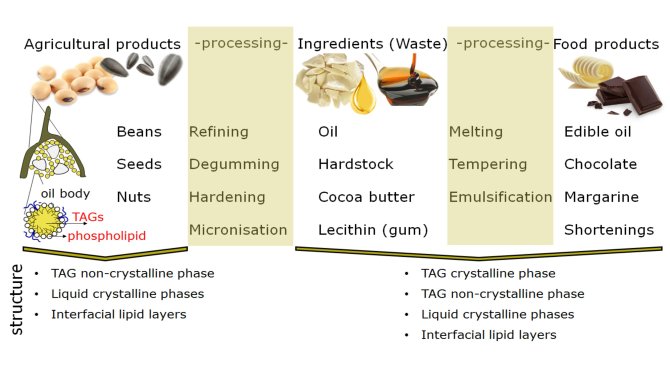Thesis subject
Multiscale Assessment of Food Lipid Structures
PhD Thesis Tatiana Nikolaeva, 6 October, 2019
Plant lipids are a major component of our diet and critically define flavour, texture, and nutritional value of food products. Oleaginous plants store lipids in their nuts, beans and seeds (Figure 1.1). Their cells contain food-relevant lipid molecules, like triacylglycerols (TAGs) and phospholipids (PLs), in so-called oil bodies (Nikiforidis, Matsakidou, & Kiosseoglou, 2014; Tzen, Cao, Laurent, Ratnayake, & Huang, 1993). In these storage organelles lipids exist in liquid and liquid-crystalline (LC) phases, the latter as interfacial layers. In order to use plant lipids in food ingredients and products, they must undergo several structural and compositional conversions in the "farm-to-fork" chain. These processing routes have schematically been depicted for several fat-continuous food products in Figure 1.1. Industrial processing involving shear, temperature and pressure can significantly modulate the self-assembly of lipids (Leser, Sagalowicz, Michel, & Watzke, 2006; Farnaz Maleky, 2015). Lipids can organise themselves in a wide range of hierarchical crystalline and LC structures, which can span multiple scales from nano-, via meso- to macro (Kulkarni, 2012; Leser et al., 2006; Michalski et al., 2013). The organisation of both multiscale crystalline and LC lipid systems is governed by interplay of molecular and colloidal interactions. These underlie the physical properties of lipid systems when they undergo melting, crystallisation, and flow.

Figure 1.1. Schematic example of lipid structures as they occur changes throughout the farm-to-fork supply chain of fat-continuous foods.
For most lipid-based food products multiscale architectures underlie critical functionalities such as shelf life stability, water holding capacity, texture and mouth feel (Marangoni et al., 2011; Ramel, Co, Acevedo, & Marangoni, 2016). Understanding of these multiscale organisations is therefore a prerequisite for designing lipid-based food products with desired functionalities. The food industry well appreciates that establishing structure-function relationships is a key step in the development of novel sustainable food formulations and processing technologies. The aim of this thesis is to develop and apply novel methodologies to characterize and quantify multiscale structures of food lipids under dynamic processing conditions. This thesis will focus on investigation of structure-function relationships of both crystalline and liquid crystalline (LC) multiscale structures composed of TAGs and
phospholipids, respectively.